Select Language

SYDNEY (Reuters) - Australian household spending rose for a fourth straight month in January, driven by a rise in services, although the annual pace of growth slowed, data showed on Friday.
The Australian Bureau of Statistics’ monthly household spending indicator (MHSI) showed a seasonally adjusted rise of 0.4% in January from December, when it rose by 0.2%.
Annual growth, however, slowed to 2.9% from 4.2% in the previous month.
Robert Ewing, ABS head of business statistics, said consumers reduced spending on goods, having already taken advantage of promotional events such as Black Friday sales at the end of last year.
"A 1.5% rise for services drove the January growth. This came as households spent more on health services, air travel, and sports and physical recreation services," Ewing said.
The MHSI series will replace the current retail sales report from July and is much broader in scope covering 68% of household consumption, more than double the retail survey.
It includes spending on many services and should offer a better guide on what to expect from household consumption in the gross domestic product (GDP) report.

By Promit Mukherjee
OTTAWA (Reuters) -Canada’s trade surplus in January exceeded expectations by a wide margin posting a 32-month record as fears of tariffs from the U.S. pushed exports of cars and energy products higher, especially south of its border, data showed on Thursday.
The trade surplus rose to C$3.97 billion ($2.78 billion), more than double the upwardly revised C$1.69 billion seen in December, Statistics Canada said, including a record surplus with top trading partner the United States.
U.S. President Donald Trump slapped a 25% tariff on almost all Canadian imports and after retaliation by Prime Minister Justin Trudeau, he has threatened to stack up more tariffs on them.
On Thursday, Trump agreed to suspend the tariffs for a month provided the products imported into the U.S. comply with the terms of the Canada-U.S.- Mexico free trade agreement.
Canada also rolled back a plan to slap a second round of retaliatory tariffs on the U.S. Its 25% tariff on C$30 billion of goods imported from the U.S. are still in place.
Analysts polled by Reuters had forecast Canada’s trade surplus to be at C$1.28 billion and have said that trade balances would benefit from companies front-loading orders in January.
"This uncertainty is creating major swings in the data, and we are just getting started," Andrew DiCapua, Principal Economist, Canadian Chamber of Commerce.
Total exports increased 5.5% in January to a record of C$74.5 billion, following a 6% increase in December. A 1% decline in the value of the Canadian dollar to its U.S. counterpart in January also led to an increase in export value, it said.
In volume terms, total exports rose 4.5% in January, following an increase of 2.6% in December.
The jump in exports was led by an over 12% jump in motor vehicles and parts, followed by a 4.8% increase in exports of energy products, data showed.
The Canadian dollar was largely stable after the data with the local currency trading weaker by 0.18% to 1.4361 to the U.S. dollar, or 69.63 U.S. cents. Yields on the two-year government bond dropped by 1.1 basis points to 2.544%.
U.S. TRADE
Canada’s trade surplus with the U.S. clocked a record of C$14.4 billion in January, from C$12.3 billion in December. This was led by historically high exports of C$58.2 billion to the U.S. Imports from the United States increased 4.7%, Statscan said.
The trade surplus with the U.S. increased for the third month in a row.
Trump has often indicated that he is unhappy that his country imports more from Canada than it exports and analysts have said that tariffs are also a tool for Trump to reverse this deficit.
However, data shows that its deficit with Canada, which is its second biggest trading partner, is much smaller than its other two top trading partners - Mexico and China.
According to U.S. government data the deficit with Mexico is almost 2.5 times that of Canada, while it is just a fifth of what the U.S. has with China.
Stuart Bergman, chief economist with Export Development Canada said Canada’s surplus with the U.S. shrinks when services trade is taken into account. In services trade, Canada runs a deficit with the U.S.
Services imports for January were down 0.4% on a monthly basis led by a slump in travel services of 5.3%, mainly on lower spending by Canadians traveling to the US, he said.
"This is clear evidence that the current situation is impacting consumer choices," Bergman said.
($1 = 1.4279 Canadian dollars)
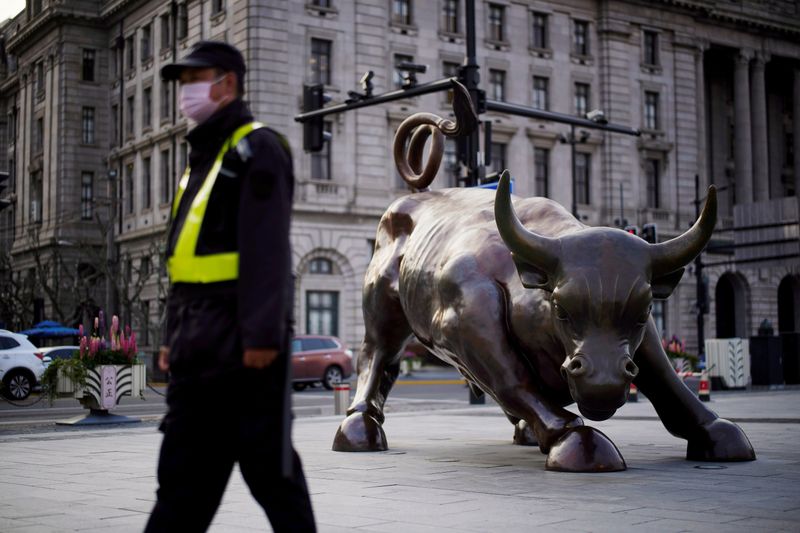
Investing.com-- Most Asian stocks jumped on Thursday led by a surge in Hong Kong shares, as President Donald Trump’s delay of 25% auto tariffs on Mexico and Canada eased immediate trade war fears, while optimism was further boosted by China’s new stimulus measures.
Major U.S. stock indexes jumped on Wednesday, in anticipation that the U.S. administration may be open to tariff negotiations.
Asia stocks jump as Trump’s auto tariff delay signals softer stance
On Tuesday, President Trump escalated trade tensions by imposing 25% tariffs on Canadian and Mexican goods, and increased levies on Chinese products to 20%.
In his congressional speech on Wednesday, Trump reaffirmed plans for reciprocal tariffs, set to take effect on April 2. This move could further escalate trade tensions.
However, the White House announced on Wednesday a one-month exemption from the newly imposed 25% tariffs on vehicle imports from Mexico and Canada, offering temporary relief to global markets.
The White House said Trump is open to considering more tariff exemptions after they took effect Tuesday.
A Bloomberg report showed that Trump is planning to exempt certain agricultural products from the tariffs imposed on Canada and Mexico.
Japan’s Nikkei 225 jumped 1.1% on Thursday, while TOPIX advanced 1.2%.
Indonesia’s Jakarta Stock Exchange Composite Index climbed 1.4%, while the Philippines’ PSEi Composite index rose 1.2%.
Singapore’s Straits Times Index gained 0.6%, while South Korea’s KOSPI was trading 0.9% higher.
India’s Nifty 50 Futures edged up 0.1%.
Bucking the regional trend, Australia’s S&P/ASX 200 index fell 0.6%.
HK shares surge on fresh China stimulus; tech sector leads gains
China announced new fiscal stimulus measures at the National People’s Congress on Wednesday to invigorate its slowing economy, setting a 2025 GDP growth target of approximately 5%.
Premier Li Qiang emphasized enhancing domestic consumption and technological innovation, particularly in artificial intelligence (AI). The government plans to increase the fiscal deficit ratio to 4% to finance consumer goods programs and bolster the tech sector.
The NPC highlighted AI’s importance, mentioning startups like DeepSeek, known for its cost-effective, high-performance AI models. This acknowledgment bolstered investor confidence in the tech sector.
Hong Kong’s Hang Seng index climbed 2.3%, while the Hang Seng TECH index surged 3.2%.
Among HK-listed tech giants, Alibaba’s (HK:9988) stock surged 6.2%, while Tencent (HK:0700) shares climbed 4.7%.
China’s Shanghai Composite rose 0.8%, while the Shanghai Shenzhen CSI 300 index gained 0.9%.
Despite ongoing U.S.-China trade tensions, including recent tariffs and sanctions, China’s commitment to AI and tech innovation has invigorated its stock markets.

HANOI (Reuters) - Vietnam posted a rare monthly trade deficit in February as imports surged during the month, government data showed on Thursday, though the country’s surplus with the United States increased in the opening months of 2025.
The Southeast Asian nation, a regional manufacturing hub, is heavily dependent on export-driven economic growth and faces risks from global trade disputes, including the potential imposition of tariffs by the United States.
Vietnam posted a trade deficit of $1.55 billion in February, after a $3.02 billion surplus in January, the General Statistics Office said. It was only the third monthly deficit since the start of 2023, as per GSO and London Stock Exchange Group (LON:LSEG) data.
February’s exports rose by 25.7% from a year earlier while imports surged by 40%, primarily due to increased imports of dairy products, automobiles and metal products, the GSO said.
Over the January-February period, the GSO said there was a trade surplus of $1.47 billion, aligning with figures published by the government on its portal the previous day.
Combining data for the two months can smooth out distortions from the timing of Lunar New Year holidays, which fell in January this year and February last year.
The GSO data showed that for the January-February period, exports rose by an annual 8.4% and imports were up by 15.9%.
U.S. SURPLUS, CHINA DEFICIT
In the first two months of 2025, Vietnam’s trade surplus with the U.S. reached $17 billion, up 16.3% from a year earlier, while its deficit with China widened by 36.9% to $15.4 billion.
Vietnam is worried about being hit with reciprocal tariffs by the U.S. government. The U.S. is Vietnam’s largest export market, while China is its biggest source of imports.
Vietnam has long been suspected of being a transshipment hub for Chinese goods to the U.S., given the huge volumes of intermediate goods it imports from China.
Other data released by the GSO showed industrial production rose by 17.2% in February from a year earlier, picking up from January’s 0.6% growth, and retail sales rose 9.4%.
Foreign investment inflows rose 5.4% in the January-February period from a year earlier to about $3 billion, and foreign investment pledges rose by an annual 35.5% to $6.9 billion.
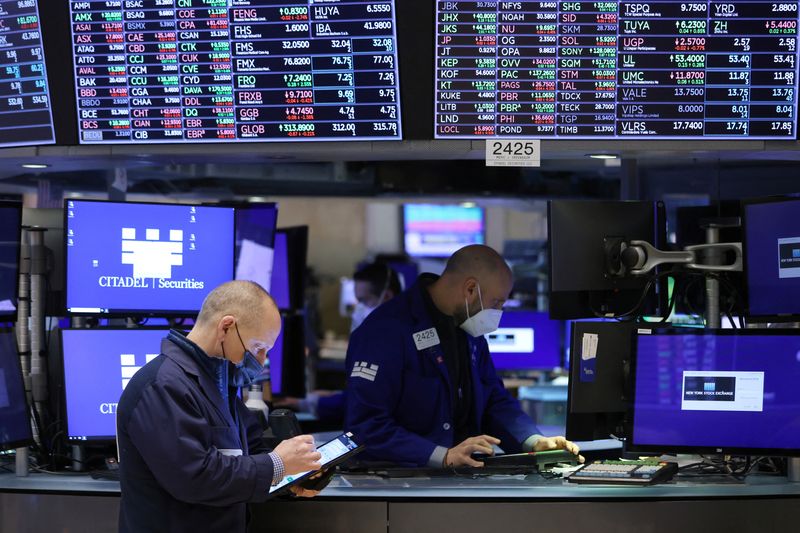
Investing.com-- U.S. stock index futures were little changed on Wednesday evening after Wall Street closed higher driven by President Donald Trump’s decision to grant a one-month exemption for automakers from the newly imposed 25% tariffs on imports from Mexico and Canada.
S&P 500 Futures were largely muted at 5,852.25 points, while Nasdaq 100 Futures inched 0.2% lower to 20,632.75 points by 19:25 ET (00:25 GMT). Dow Jones Futures were unchanged at 43,068.0 points.
Markets get respite as Trump defers auto tariffs
The White House announced on Wednesday a one-month exemption from the newly imposed 25% tariffs on vehicle imports from Mexico and Canada, offering temporary relief to U.S. automakers.
This exemption allows manufacturers additional time to adjust their supply chains and explore long-term solutions, mitigating immediate financial pressures.
Both neighboring countries are integral to the North American supply chain, with numerous parts and vehicles crossing borders multiple times during production. The United States-Mexico-Canada Agreement (USMCA) underscores this relationship, setting content rules that many vehicles already comply with, and ensuring duty-free access.
Meanwhile, Bloomberg News reported that Trump is considering exempting certain agricultural products from the tariffs imposed on Canada and Mexico.
These developments suggest the administration may be open to negotiations for lasting tariff solutions.
The stock market responded positively to the exemption announcement.
The Dow Jones Industrial Average closed 1.1% higher on Wednesday, ending a two-day losing streak. The S&P 500 also advanced by 1.1%, while the NASDAQ Composite climbed 1.5%.
Notably, shares of major automakers jumped, with General Motors (NYSE:GM) advancing 7.2%, and Ford (NYSE:F) climbing 5.8%.
Stellantis NV (BIT:STLAM) shares surged 9.2%, while U.S.-listed Toyota Motor (NYSE:TM) shares jumped 6.5%.
Investors assess services activity data; key jobs report awaited
Data on Wednesday showed that the U.S. services sector experienced unexpected growth in February, with the Institute for Supply Management’s (ISM) Services PMI rising to 53.5 from January’s 52.8, surpassing forecasts.
However, input prices also increased, exacerbated by new tariffs imposed by President Trump’s administration.
These tariffs, coupled with rising raw material costs at factories, suggest inflation may increase in the coming months.
Investors are now keenly awaiting Friday’s employment report, to gauge the health of the U.S. economy, and the Federal Reserve’s future interest rate trajectory.

SEOUL (Reuters) - South Korea’s consumer inflation softened in February for the first time in four months, government data showed on Thursday, providing at least some relief to policymakers looking to further ease monetary policy.
The consumer price index (CPI) rose 2.0% from a year earlier, slower than a gain of 2.2% in the previous month, according to Statistics Korea. It was slightly higher than a median 1.95% increase tipped in a Reuters poll.
The slowdown in February came after inflation accelerated in January to a six-month high, driven by a weak won, and above the central bank’s medium-term target of 2%.
The won has strengthened 2% against the dollar this year to trade at 1,444.2 per dollar on Thursday, after weakening more than 12% last year for its biggest drop in 16 years on domestic political instability.
"Going forward, consumer inflation is expected to fluctuate around the target level amid mixed factors of a weak local currency and low demand pressure," the Bank of Korea said after the data release.
Last week, the central bank cut interest rates and said there would be more easing this year, steering Asia’s fourth-largest economy from a restrictive monetary policy stance towards an accommodative one to support growth.
CPI rose 0.3% on a monthly basis, compared with gains of 0.7% in the previous month and 0.2% expected by economists.
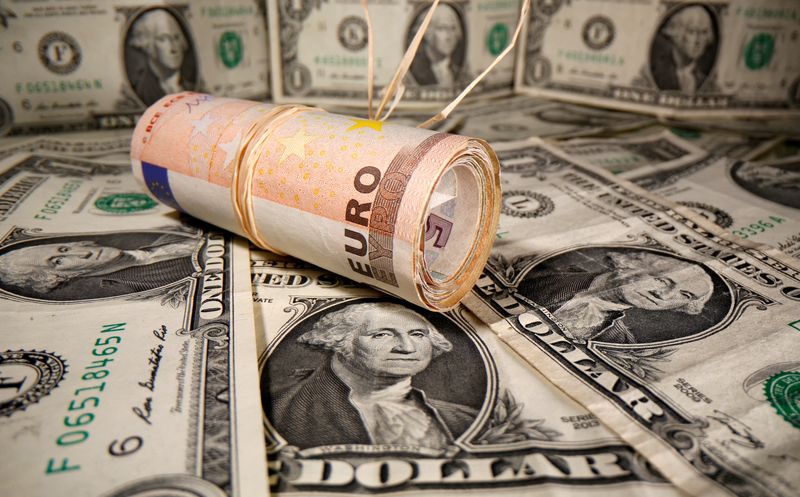
By Gertrude Chavez-Dreyfuss
NEW YORK (Reuters) -The euro ascended to four-month highs on Wednesday against the U.S. dollar, as Europe’s growth prospects improved after Germany’s proposed 500 billion euro ($531 billion) infrastructure fund, potentially offsetting global trade tensions.
The greenback, on the other hand, fell against most currencies, weighed down by an uncertain growth outlook driven by fears about the impact of tariffs on inflation and the economy. Investors are now starting to price in the potential for outright U.S. contraction, with traders on the prediction market Kalshi currently implying a 42% chance of a U.S. recession this year.
"We are experiencing a change in sentiment when it comes to relying on American markets," said Juan Perez, director of trading, at Monex USA in Washington.
"If things are headed towards a restrictive protectionism, the financial system will start making adjustments and right now it seems shedding dollar positions is prudent. If tariffs and trade wars are perceived as negative on the American economy, we return to speculation over the chances for looser monetary policy."
The euro, meanwhile, climbed 4% this week, on track for its best week since November 2022, taking another leg higher after a late Tuesday announcement from the parties hoping to form Germany’s next government of the planned new fund and an overhaul of borrowing rules.
It rose to its highest since November 8 against the dollar and was last up 1.5% at $1.0791, on pace for its best daily gain since November 2023. The euro also gained against other currencies, including the British pound, the Japanese yen and the Swiss franc,.
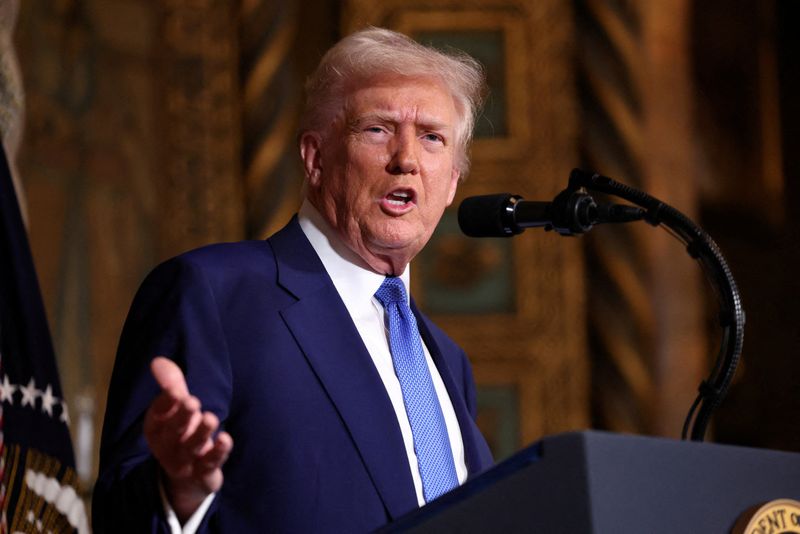
Investing.com-- U.S. President Donald Trump repeated his plans for tariffs against America’s biggest trading partners during an address to Congress on Tuesday evening, calling for an end to what he saw as unfair trading practices.
His comments came as Trump’s 20% tariffs on China and 25% tariffs on Canada and Mexico took effect earlier in the day, potentially marking the beginning of a global trade war.
Trump said reciprocal tariffs against major economies- which will match their tariffs on U.S. exports- will take effect from April 2. He lambasted unfair trading conditions for U.S. companies, citing India and South Korea’s automobile duties as an example.
“We’ve been ripped off for decades, and we will not let that happen any longer,” Trump said. “Tariffs are about making America rich again, making America great again.”
Trump also said he wants to make interest payments on American-made automobiles tax deductible.
Trump claimed that his policies will benefit American farmers, but warned that there would be a bit of an “adjustment period” after he announced tariffs on agricultural imports, beginning from April 2.
In his first address to a joint session of Congress since taking office in January, Trump outlined what he touted as major achievements for his administration over the past six weeks, which included stricter border controls, measures to increase domestic energy production, and cuts to government spending.
Trump reiterated his plans for sweeping tax cuts, calling on the Democrats to also vote in favor of a proposed tax cut bill.
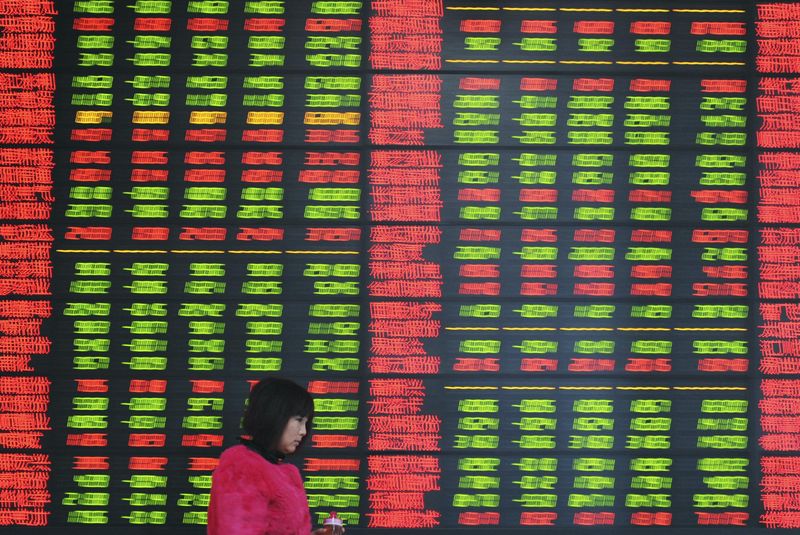
Investing.com-- Most Asian stocks rebounded on Wednesday amid hopes that U.S. President Donald Trump may negotiate the steep tariffs imposed on Mexico, Canada, and China, just a day earlier, while Australian shares declined despite data showing robust economic growth in the fourth quarter.
Regional equities also drew cues from a jump in U.S. stock index futures in Asia hours. Major U.S. stock indexes ended sharply lower on Tuesday after Trump’s announcement.
Asia stocks get respite from prospects tariff negotiations
On Tuesday, President Trump escalated trade tensions by imposing substantial tariffs on imports from Canada, Mexico, and China.
A 25% tariff was levied on Canadian and Mexican goods, while tariffs on Chinese products were increased to 20%.
These measures prompted swift retaliatory actions as Canada announced immediate 25% tariffs on U.S. imports worth C$30 billion, and China imposed 15% tariffs on U.S. agricultural imports, including chicken and wheat, along with 10% on products like soybeans and pork.
In an interview with Fox Business on Tuesday, U.S. Commerce Secretary Howard Lutnick indicated that President Trump might be open to negotiations to resolve the escalating trade disputes.
This suggestion of potential dialogue introduced a degree of optimism in global markets.
Japan’s Nikkei 225 rose 0.5% on Wednesday, while TOPIX was largely unchanged.
Hong Kong’s Hang Seng index jumped 1.5%, rebounding from steep losses in the previous session.
Indonesia’s Jakarta Stock Exchange Composite Index jumped 2.9%, leading the gains among regional bourses.
Singapore’s Straits Times Index gained 0.3%, while Malaysia’s KLCI index rose 0.6%.
South Korea’s KOSPI jumped 0.9%.
India’s Nifty 50 edged 0.2% higher at open on Wednesday.
Australia’s Q4 GDP grows more than expected
Data on Wednesday showed that Australia’s Gross Domestic Product (GDP) grew by 0.6% in the fourth quarter of 2024, surpassing the previous quarter’s 0.3% growth and exceeding market expectations of 0.5%.
On an annual basis, GDP increased by 1.3%, up from 0.8% in the third quarter, driven by strong public and private investment, as well as a rebound in the terms of trade.
Despite the positive data, Australia’s S&P/ASX 200 index was trading 0.8% lower, as local investors were assessing the impact of tariffs on Australia’s biggest trade partner China.
China targets 5% GDP growth in 2025; parliamentary meeting in focus
China’s Shanghai Composite rose 0.3%, while the Shanghai Shenzhen CSI 300 index gained 0.4%.
China has set a 2025 economic growth target of around 5%, media reports said, citing official documents.
Premier Li Qiang will present it at the National People’s Congress, which began on March 5.
Amid U.S. tariffs and trade tensions, China plans fiscal measures, including a higher budget deficit and 1.3 trillion yuan in special treasury bonds, reports stated.
China’s annual parliamentary meeting, also known as "Two Sessions", is being held from March 5 to March 11 this week in Beijing.

Investing.com-- Oil prices fell slightly in Asian trade on Wednesday as markets remained on edge over tariff-related headwinds and increasing global production, with focus turning to stimulus measures in top importer China.
Prices had tumbled to a five-month low on Tuesday as investors fretted over worsening demand amid economic headwinds from increased U.S. trade tariffs. This came as U.S. President Donald Trump delivered on his threats of higher tariffs against China, Canada, and Mexico.
Oil markets were also rattled by reports that the Organization of Petroleum Exporting Countries and allies (OPEC+) will proceed with a plan to begin increasing production, albeit marginally, from April.
Still, crude prices found some relief from China- the world’s biggest oil importer- setting a 5% economic growth target for 2025 while outlining a slew of stimulus measures. Industry data also showed a bigger-than-expected draw in U.S. inventories.
Brent oil futures expiring in May fell 0.2% to $70.93 a barrel, while West Texas Intermediate crude futures fell 0.3% to $67.46 a barrel by 20:51 ET (01:51 GMT). Both contracts remained close to a five-month low hit earlier this week.
China targets 5% GDP, outlines stimulus plans
China set a gross domestic product target of 5% for 2025, keeping the figure unchanged for a third consecutive year.
The figure was revealed at the opening of the annual meeting of the National People’s Congress, China’s most important political meeting.
Beijing outlined a higher budget deficit for 2025, heralding more fiscal spending, and also promised more action to boost local consumption, which has been a major point of pressure on local growth.
Beijing will also ramp up its debt issuance in 2025 to allocate more resources towards consumer subsidies.
US inventories see bigger-than-expected draw- API
Data from the American Petroleum Institute showed that U.S. oil inventories shrank nearly 1.5 million barrels in the week to February 28, more than expectations for a draw of 0.3 mb.
The reading usually heralds a similar print from official inventory data, which is due later on Wednesday. U.S. inventories shrank last week after four straight weeks of outsized builds.
But signs of a draw in the past week raised some hopes that fuel demand was improving and U.S. supplies were tightening.
Oil prices were battered by Trump also calling on higher energy production, domestically and abroad.

